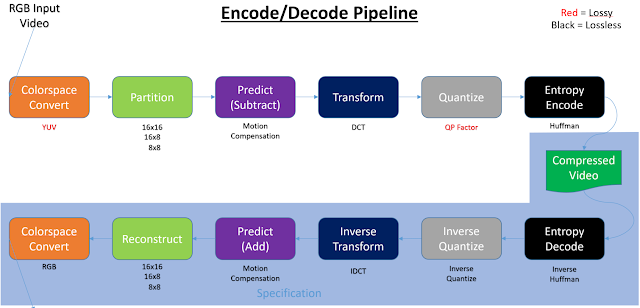VP9 Video Encoding/Decoding Support On A PC
Introduction
Video decoding/encoding can take place in the
following four types of silicon:
1. General purpose CPU silicon (x86, ARM, SSE, AVX, …)
2. Dedicated CPU silicon (Intel QuickSync, AMD VideoCoreNext)
3. General
purpose GPU silicon (cores) (GPGPU, Cuda, OpenCL, Shaders, …)
4. Dedicated GPU silicon (NVidia PureVideo (decode), NVida NVENC (encode))
4. Dedicated GPU silicon (NVidia PureVideo (decode), NVida NVENC (encode))
(Table 1)
When video is encoded or decoded any combination of the above silicon can be used.
Being this paper is focused on everyday PCs,
I’ve left out things like FPGAs, but you could consider an FPGA solution to be
more like a general purpose GPU silicon solution.
Encoding and decoding of video has a defined
pipeline:
When encoding or decoding video, any one of
those colored blocks can be done in hardware or software. Sometimes a full software approach is taken,
sometimes a full hardware approach is taken, and sometimes any combination of
hardware and software is taken (a hybrid approach) as you progress through the
pipeline.
Video Decoding
To decode a video stream, the person
implementing the decoder can choose different combinations of silicon to use
for each of the colored blocks in the diagram.
Here are some sample combinations, not an exhaustive list:
- Elementary
stream parsing and entropy decode done on the general purpose CPU, with
the rest of the video decode done by GPGPU code.
- Elementary
stream parsing and entropy decode done on the general purpose CPU, with
the rest of the video decode done by dedicated SIP silicon.
- The entire
video stream decoded in dedicated SIP silicon.
Now days, most vendors provide an SIP which
carries out the entire video encode and decode pipeline, so most of the time #3
above is the common use case. But be
aware that the hybrid approach (any mix of the four silicon types mentioned in
Table 1) exists.
VP9 Support on PC’s
The NVidia API that carries out video decoding
is called NVDEC.
NVDEC can offload video decoding to full fixed-function decoding
hardware (Nvidia PureVideo), or (partially) decode via CUDA
software running on the GPU, if fixed-function hardware is not available.
The NVidia API that carries out video encoding
is called NVENC.
The NVENC API is the only way to access the NVidia NVENC SIP core.
AMD
AMD
Video
Core Next is AMDs latest version of its SIP video encoding and
decoding core and it exists on the processor’s die or on an AMD GPU. It replaces the Video Coding Engine that was introduced in
2011, which replaced the Unified Video Decoder.
To understand Video Core Next and the earlier Video Coding Engine, see this article. Note that the article mentions fully fixed encoding (all dedicated silicon) and hybrid encoding (dedicated silicon and OpenCL). These types of approaches are mentioned in Table 1.
To understand Video Core Next and the earlier Video Coding Engine, see this article. Note that the article mentions fully fixed encoding (all dedicated silicon) and hybrid encoding (dedicated silicon and OpenCL). These types of approaches are mentioned in Table 1.
Intel
Intel Quick Sync Video is Intel’s version of
its SIP video encoding and decoding core and it exists on the processor’s die,
it is not a separate GPU.
VP9 Testing Matrix
NVidia (PureVideo), seems to have VP9 support as of
PureVideo’s seventh generation (VP7), starting with the GeForce GTX 960 and
950. This generation of PureVideo HD
corresponds to Nvidia Feature Set F (or "VDPAU Feature Set F").
Here is my usual go to page to figure out
NVidia HW encode and decode support.
AMD (Video Core Next), seems to have added VP9
decode in its Raven Ridge APU (SIP), which dates from January 2018. I would expect AMD’s previous engine, the Video Coding Engine, to have VP9 hardware
support, but I can’t find any supporting information.
Note: AMD marketing coined the term APU, which is a CPU and GPU on a single
die. Intel CPUs also integrate GPU
components onto a single die, but Intel calls this a CPU with integrated
graphics. Yay marketing...
AMD provides APUs and GPUs. Both of these products have built-in VP9 decoding silicon. I don’t see AMD APUs listed in this document. The Raven Ridge APU design exists in the Ryzen 3 2200GE APU and above.
AMD provides APUs and GPUs. Both of these products have built-in VP9 decoding silicon. I don’t see AMD APUs listed in this document. The Raven Ridge APU design exists in the Ryzen 3 2200GE APU and above.
Intel (QuickSync), seems to have added partial VP9
decode as of Version 5 (Skylake), full VP9 decode started with Version 6 (Kaby
Lake) in 2016.


Comments
Post a Comment